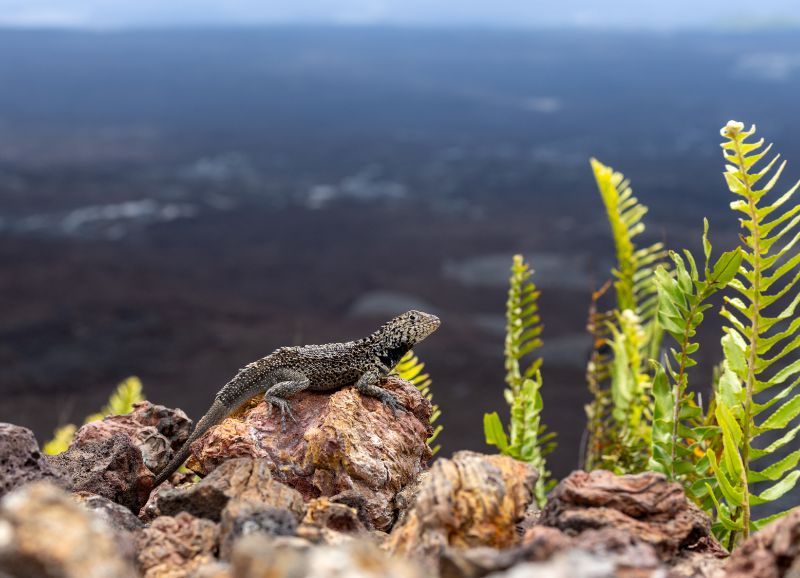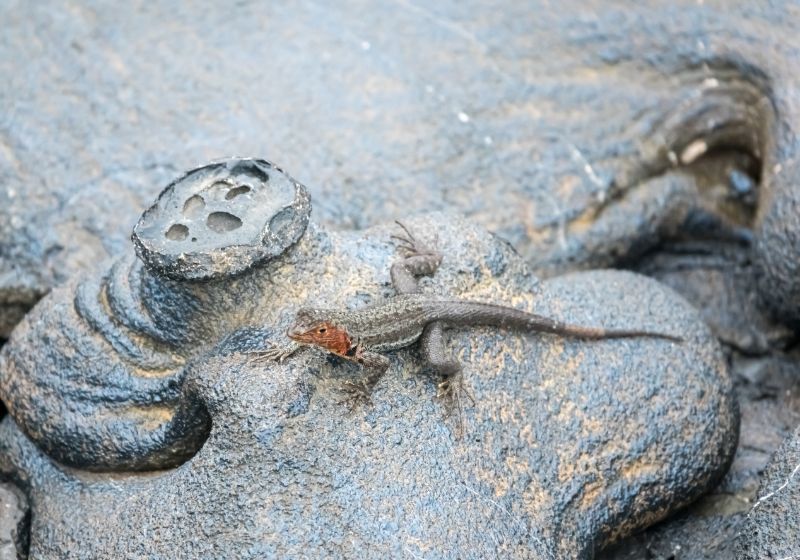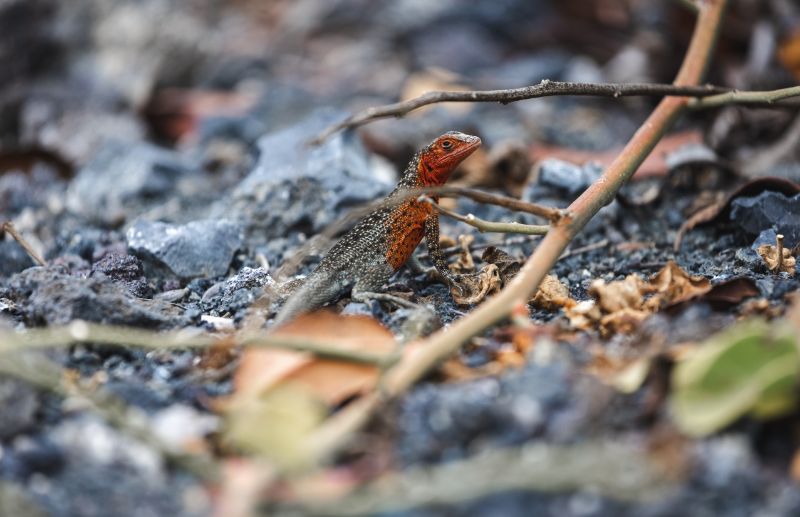Welcome to the riveting world of the Lava Lizard, a group of reptiles that has intrigued scientists for generations. These creatures, known as Tropidurus, are found basking under the sun in distinct sections of the Galapagos Islands and exhibit many captivating characteristics.
Lava lizards, belonging to the genus Microlophus, are a striking example of the rich biodiversity that thrives within the Galápagos Islands and along South America’s coastal Andean regions. These reptiles are distinctly adapted to their environments, displaying a variety of behaviors and physical attributes that allow them to flourish in these unique habitats.
With about 20 species recognized within the genus, ten can be found exclusively in the Galápagos, where they are not just prevalent but also a symbol of the archipelago’s extraordinary ecosystem.
The species of lava lizards that call the Galápagos home have each carved out a niche on different islands, demonstrating a fascinating case of adaptive radiation.
This evolutionary process, where species diversify rapidly from an ancestral species to fill various ecological roles, is vividly exemplified by these lizards’ ability to live amongst the volcanic landscapes where their coloration helps them to remain camouflaged against the lava rocks. The remaining species of Microlophus, often referred to as Pacific iguanas, inhabit areas extending from the Andes to the Pacific coasts of Chile, Peru, and Ecuador.
In an environment as demanding as the Galápagos or the Andes, the lava lizard’s success can be attributed to its versatile feeding habits, effective reproductive strategies, and resilient nature. These characteristics, coupled with the lizards’ generalist approach to survival, allow them to play a crucial role within the ecological fabric of their respective regions. The study and conservation of these lizards are essential for their preservation and understanding of the broader ecological dynamics at work in these unique ecosystems.
Taxonomy and Evolution

In exploring the lineage of lava lizards, one will find a remarkable narrative of evolution and diversification, particularly within the genus Microlophus. These species exemplify adaptive radiation, a process significantly influenced by the Galápagos Islands’ unique environment.
Classification of Lava Lizards
The Tropiduridae family houses a variety of lizards, among which the lava lizards are notable for their adaptive qualities. Currently recognized species within the genus Microlophus have been subjects of extensive taxonomic scrutiny, having undergone revisions since their initial description. The genus was previously conflated with Tropidurus, another member of the Tropiduridae family. However, morphological and genetic analyses have led to a clearer understanding of the lava lizards’ classification.
- Family: Tropiduridae
- Genus: Microlophus
- Notable Species: Microlophus albemarlensis (Galapagos Lava Lizard)
Adaptive Radiation
Charles Darwin’s observations in the Galápagos Islands played a pivotal role in the development of evolutionary theory, where the principle of adaptive radiation is well-exemplified by lava lizards. Each island’s unique ecological niches have driven the lava lizards to diverge into multiple species.
This speciation reflects their morphological adaptations to varied habitats, from arid lowlands to humid highlands, demonstrating a classic case of adaptive radiation. The spread of lava lizards across the islands with distinct ecological conditions underpins the incredible biodiversity of the archipelago.
Physical Description
Lava lizards are notable for their adaptive physiques, which enable them to thrive in the Galapagos’ harsh environmental conditions. These reptiles exhibit a range of physical adaptations that are key to their survival.
Distinctive Features
Male lava lizards are recognizable by their robust builds and often vibrant throat colors that play a role in their territorial displays. Females tend to have slimmer bodies and less pronounced coloration. Pointed heads are a common feature among both sexes, contributing to their streamlined appearance.
Sexual Dimorphism
In terms of size, sexual dimorphism is prominent in these species; males are generally larger than females, sometimes reaching up to a foot in length, while the females are usually smaller. The color of males is also more pronounced, with combinations of yellow, black, and brown, which starkly contrast against the females’ more muted tones. The throat of the male can be quite striking, a spectacle used during their displays to competing males or when courting females.
Distribution and Habitat
The Galapagos Lava Lizard thrives exclusively within the Galapagos archipelago, a testament to its adaptation through island endemism. These reptiles display preferences for very specific habitats that cater to their survival needs, including adequate sun exposure and protective environments.
Island Endemism
Galapagos Lava Lizards are prime examples of endemic species, meaning they are found nowhere else in the world except in the Galapagos Islands. Each island within the archipelago, like Santiago, Santa Cruz, Isabela, and Fernandina, has become home to these unique lizards.
Smaller islands such as Seymour, Baltra, Santa Fe, Rábida, and Daphne Major also support their populations. This geographical solitude has led to the species’ specialization and diversification across the various islands.
Habitat Preferences
Lava Lizards prefer habitats that blend sun-soaked clearings with natural shelters. During the day, they can often be found basking on rocks and soil to regulate their body temperature with the warmth of the sun. At night, they seek refuge in leaf litter and other ground litter, which provides insulation and camouflage from predators. Their preferred terrain often consists of rocky substrates, which closely align with the volcanic and rugged terrain of the Galapagos Islands, far from the mainland of South America.
Behavior and Ecology
Lava lizards exhibit a complex range of behaviors and ecological interactions that are essential for their survival in their native habitats. These behaviors impact not only their individual lives but also the ecological systems they inhabit.
Dietary Habits
Lava lizards are omnivores, with their diet encompassing a wide variety of arthropods, including ants and spiders. They forage actively for these foods, which provide the necessary nutrients for their growth and development.
Reproductive Behavior
During the breeding season, males and females engage in conspicuous courtship displays. Females lay eggs after mating, with sexual maturity being reached relatively quickly. This rapid maturation ensures the continual propagation of their species.
Territoriality and Defense Mechanisms
These reptiles are highly territorial. Males defend their territory through visual displays such as push-ups, biting, and tail slaps. Rarely there is evidence of cannibalism, demonstrating the intense competition for resources within their habitats.
Interactions with Other Species
Lava lizards play vital roles within the Galápagos ecosystem, particularly in their interactions with other species. They influence both the biological and ecological facets through various predator-prey dynamics and symbiotic relationships.
Predators and Threats
By their very nature, lava lizards are caught in a constant struggle for survival. Among their natural predators are hawks and herons, who see these reptiles as a convenient source of nutrition. Additionally, the young are especially vulnerable and often find themselves targeted by a range of opportunistic feeders.
Those that manage to evade immediate threats must still contend with environmental challenges. Climate change poses a significant risk, potentially disrupting their habitat and food availability. As species with a vulnerable status on the IUCN Red List, the conservation of their environment remains paramount to their continued existence in the Galápagos.
Symbiosis and Competition
In terms of ecological cooperation, marine iguanas and lava lizards display a fascinating form of mutualism. Lava lizards benefit from feeding on the flies attracted to the iguanas. The iguanas, in contrast, enjoy a level of pest control as a result. This relationship exemplifies the interdependence observed in ecosystem dynamics.
However, competition for resources is also a part of the lava lizard’s life. They may compete with other reptiles for food, such as seeds and leaves, which constitutes a significant portion of their diet. To avoid confrontation, lava lizards have adapted behaviors such as camouflage to hide from predators and competitors.
Conservation Efforts
Efforts to conserve the lava lizards of the Galápagos Islands involve assessing their conservation status, identifying threats, and implementing protective measures to ensure their ongoing survival in this unique ecosystem.
Current Conservation Status
Lava lizards, being endemic to the Galápagos Islands of Ecuador, have adapted to this unique environment through a process known as adaptive radiation. They are not currently listed on the IUCN Red List, suggesting that their population is generally considered to be of Least Concern. However, constant monitoring is crucial as their populations’ stability may change with climate alterations or other ecological factors.
Threats to Survival
The habitat destruction caused by human activities poses a real danger to the survival of these lizards. The introduction of non-native species, such as cats and rats, has also disrupted the natural predators in the food chain, further threatening the lizards. Climate change looms as a broad threat, potentially altering the habitats and affecting the delicate balance that the lizards depend on.
Protection Measures
Conservationists actively aim to protect lava lizards by managing the risks posed by introduced species and guarding against human-induced habitat destruction. These measures are designed to maintain the ecological integrity of the Galápagos Islands. Conservationists based in the Galápagos and in other nations, like Peru, implement strategies to mitigate human impact and ensure the lizards continue to play their part in their native food chain.
Notable Species of Lava Lizards
In the pantheon of reptiles native to the Galápagos Islands, a few species of lava lizards stand out due to their distinctive attributes and adaptations. The following subsections will zero in on two particularly significant species that draw attention—both scientifically and from conservationists.
Galápagos Lava Lizard
Microlophus albemarlensis, commonly known as the Galápagos Lava Lizard, exemplifies the distinct evolutionary paths taken by fauna on the islands. This species is primarily found on islands such as Isabela and Santa Cruz.
The species showcases sexual dimorphism: males are larger and exhibit more vibrant colors than females. Notably, the male’s throat contrasts black and yellow, while the female tends more towards red hues. More on Galápagos Lava Lizard can be discovered here.
Floreana Lava Lizard
Another noteworthy species is the Microlophus delanonis, or Floreana Lava Lizard. This lizard resides exclusively on Floreana Island, and it exemplifies how environmental isolation leads to unique traits within a species. They are a representation of the biodiversity that thrives in the Galápagos archipelago. This lizard is one of the many under careful study due to its limited habitat and the pressures from invasive species.
Field Study and Research
Field studies of lava lizards have significantly advanced our understanding of these reptiles, shedding light on the nuanced dynamics of their habitat and behavior patterns. These studies allow researchers to observe the lizards in their natural environment, providing critical insights into their interaction with the ecosystem.
Observational Techniques
Technological advancements have revolutionized the way observational studies are conducted. Researchers utilize high-resolution photography and videography to document the lava lizards’ behaviors without intrusion. In the Galapagos Islands, scientists track the Tropidurus albemarlensis, meticulously recording their dietary habits, including insects and occasionally plant material. They also employ precise GPS tracking devices to monitor movement patterns, offering data on habitat utilization and territory ranges.
Research Contributions
Field studies contribute substantially to herpetological knowledge. The documentation of lava lizards’ size and growth rates helps in understanding their life cycle. It reveals how they incubate their eggs and care for their infants.
Moreover, they highlight the resilience of these reptiles during dry spells, a pivotal factor for their survival. Ecological interactions, like the lava lizard’s role in controlling populations of scorpions, are also elucidated, emphasizing the lizard’s importance within their habitat.
A Case for Evolution
Each type of Lava Lizard found on the Galapagos Islands points towards a thrilling debate in the scientific community about the theory of evolution. Each species of this Lizard, seven in total, inhabits different areas of these islands. Notably, these varieties might have evolved from a single Tropidurus, adapting uniquely to different environmental conditions.
On the other hand, there’s also a school of thought that suggests these differences always existed, challenging the theory of evolution. While the jury is still out on this one, it adds to the mystique of these splendid reptiles.
The Dining Habits and Defense Mechanism of The Lava Lizard

Focused on a diet of insects, moths, and plants, these Lizards are on the menu for certain birds and centipedes. However, they are armed with an ingenious escape strategy. When under threat, a Lava Lizard can shed its tail, leaving the predator befuddled with the still-wriggling tail while it escapes. Even more astonishing is their ability to regenerate this tail, providing multiple ‘get out of jail’ cards.
The Camouflage Chronicle
The Lava Lizard’s exotic color schematics add to its visual appeal and provide an effective camouflage against potential threats. Some species even hold the ability to change their color to blend seamlessly into the surroundings.
See Related: The Fascinating Journey of Bullfrog Tadpoles
Gender Dynamics Amongst Lava Lizards

Size disparity is prominent between male and female Lava Lizards, whereby the males are usually thrice the size of the females. Male Lizards are territorial by nature and engage in some ‘macho’ behavior to assert dominance – pushups. They serve as a warning to rivals and sometimes even a show of strength to woo female Lizards. Here are some of their daily activities:
- Basking in the sunlight to warm their cold-blooded bodies
- Hunting for food
- Engaging in courtship rituals
Another fascinating trait is their fearlessness of humans, suggesting a regular occurrence of Lava Lizards darting at your feet! Thus, these remarkable creatures are not just aesthetically appealing, but they also offer intriguing insights into the complex world of animal behavior, survival strategies, and evolution.
Related Resources: